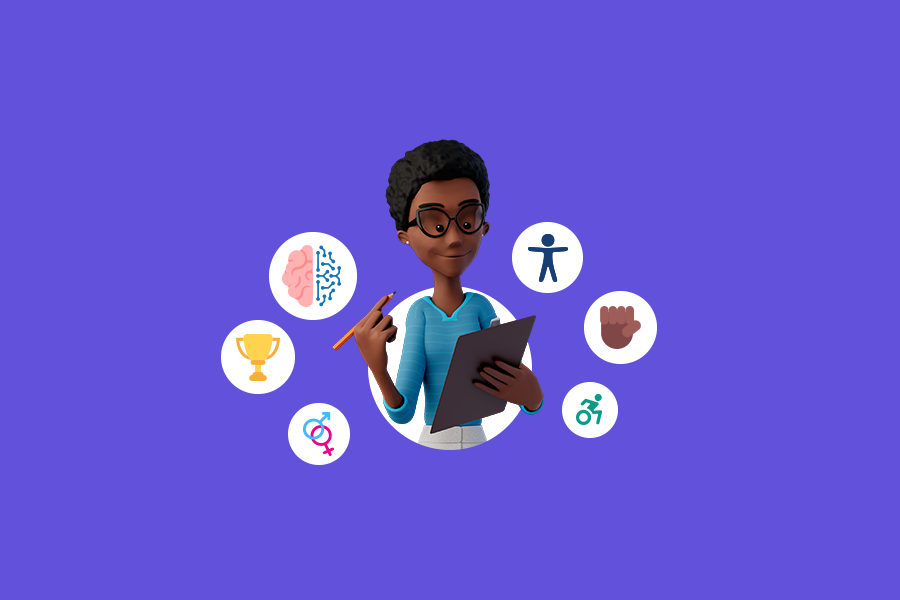
Diversity Committee: what it is and how to create in your company?

Society has recently become more attentive to issues of equity and respect. This change in behavior has also reached the workplace, making companies realize the importance of inclusion. The role of HR in this journey is essential, as it is responsible for developing inclusive actions, such as creating a diversity committee.
This type of program can generate both cultural and interpersonal benefits, as well as increase talent attraction and enhance the company’s employer brand.
Would you like to better understand how this is possible and how to set up a diversity committee in your company? If so, read on to the next sections!
What is a diversity committee?
It’s a committee comprised of diverse employees, including both leaders and team members. Its goal is to drive cultural changes within the company, fostering greater inclusivity and diversity.
This approach can assist individuals from various communities in entering the job market, attracting future talents, and improving the dignity and quality of life for these minority groups.
When forming the committee, it’s important for the group to be composed of diverse individuals, such as:
- Black individuals;
- Women;
- People with disabilities;
- Individuals over 50;
- LGBTQIA+ community members;
- Foreigners and immigrants.
However, it’s crucial to emphasize that all employees should feel invited to participate. This ensures that everyone’s voices are heard and ideas are debated, thereby preventing the formation of so-called “social bubbles.”
How to create a committee in your company?
Creating a committee in your company may seem like a challenge at first, but there’s a plan you can put into action to effectively promote diversity and inclusion in the workplace. The first step to take is:
Conducting an internal survey
It’s crucial that HR conducts a survey initially to understand the extent of diversity within the organization. This is important to gauge whether representation is an organizational shortfall or not.
Furthermore, there should be a discussion or forum to gather employees’ opinions on the establishment of the committee. This way, if there’s any resistance or negativity, HR can implement lectures and events that foster diversity, thus aiding in the social education of professionals.
Developing an action plan
After listening to your employees and understanding them better, it’s time to put ideas in practice. Here, HR’s role will be to structure this committee so that its project assists the company as a whole.
It’s important that 4 pillars are included in this process. They are:
- recruitment and selection;
- criteria for promotion;
- benefits policy;
- complaints channel.
Each of them requires specific actions focused on diversity and inclusion in the company. This way, it will be easier to strengthen diversity values in the organizational culture, and it will be possible to measure results later on.
Having organization and knowledge
As previously mentioned, there needs to be governance for organization and goal setting. This way, there will be a clear division of tasks, sectorizations, and planning, avoiding unnecessary overloads.
Furthermore, maintaining a quest for knowledge will ensure that new ideas constantly emerge. And it’s possible, in fact, that this action be shared not only among the committee members but also with the other employees of the company.
In this way, everyone enhances their perceptions of racial diversity, gender, LGBTQIA+, among others.
What benefits does the diversity committee bring to the company?
When a company becomes more diverse and inclusive, improvements are noted for both employees and the organization.
According to the Global Diversity and Inclusion Survey, 76% of companies are investing in a more diverse organizational culture. In fact, they report it as one of their priorities to enhance employer branding strategy.
And just like the name suggests, the benefits that a diversity committee offers are numerous. Here are some examples:
| For Employees | For the Company |
|---|---|
| improved quality of work life | greater profitability |
| stimulates creativity | greater connection with customers |
| fosters empathy and respect | talent retention |
| reduction of prejudiced conflicts | decrease in turnover rate |
| increases commitment level | fosters innovation and diverse ideas |
How can the committee work on accessibility in the company?
Accessibility within the company is one of the issues that should be addressed within the diversity committee to make the institution inclusive for people with disabilities. This aligns with the Web Content Accessibility Guidelines (WCAG) standards and the Americans with Disabilities Act (ADA).
However, true diversity is not evident in companies. Did you know that only about 21% of people with disabilities are employed, while over 65% of people without disabilities have gainful employment? However, this situation can be changed by increasing the number of positions allocated to this group.
Furthermore, accessibility should extend to other areas within the company. Some good accessibility practices to be implemented in companies include:
Communicational accessibility
In terms of direct actions, we have communicational accessibility, which aims to make information understandable for all individuals. It should be implemented in both interpersonal and written communication, as well as in virtual spaces.
The latter can facilitate communication for people with visual disabilities, for example. Through tools like audio descriptions or alternative texts on images, information can be conveyed to those who also face challenges in reading.
Architectural accessibility
This second factor addresses the obstacles that people with disabilities face in enjoying and accessing public and private spaces. There should be no barriers in these environments that hinder the social participation of people with disabilities or reduced mobility.
In other words, your company needs to have an inclusive and accessible space, ranging from street and sidewalk access to mobility and use of the physical space. This care should also extend to the arrangement of furniture, the type of flooring, door openings, among others.
Attitudinal accessibility
Lastly, we have attitudinal accessibility. This can be subtly perceived but makes a significant difference in people’s daily lives. It involves interpersonal practices aimed at reducing differences and including diversity in a more natural way.
Here, HR can work effectively by promoting inclusive education that eliminates segregation, stereotypes, and prejudices possibly found among employees. It’s a matter of attitude that will bring greater well-being and overall quality of work life.
How to measure results?
Just like any corporate initiative, it’s important to monitor the progress and outcomes of the project. In the case of the diversity committee, there are 4 key factors for measuring effectiveness:
- Representation: simply conduct an internal survey to determine the percentage of employees who belong to any of the groups or communities encompassed by the action.
- Retention: this involves measuring the turnover rate before and after the implementation of the inclusive action plan. This way, you can compare and determine if there has been an effect on talent retention.
- Monitor the recruitment stage: this ****means analyzing the rate of diverse candidates recruited in the last period. This allows the company to see if hiring practices are becoming more inclusive or not.
- Promotion and development: this is to measure the career progression rate of employees, as well as the effectiveness of training programs and other promotions within the corporation. This way, the company can observe if there is a pattern beyond the professional aspect for this internal advancement.
By implementing this framework, diversity and inclusion go much further, making your company truly welcoming, empathetic, and diverse!
Did you enjoy learning about how major brands are investing in accessibility and representation? To find out how to implement diversity and inclusion in your company as well, keep following the Hand Talk blog and stay informed about everything!



